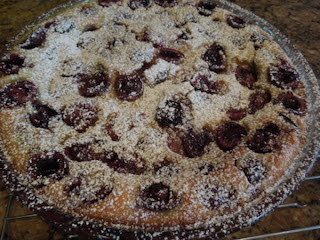Trying out Belinda Leong's Cherry Clafoutis Recipe
Cherry clafoutis is sort of like a tarte tatin or a fruit
crumble in that the end result is so much more impressive than the labor that
went into producing it seemed to suggest.
(The opposite might be said of the Thomas Keller madeleines recipe that
I recently reviewed.) In fact, Will and
I made two cherry clafoutis in the last few weeks. We don’t normally like to repeat a dessert so
soon—or most dishes for that matter—but cherries are in season, and we had just
enough extra almond meal we’d ground up for the first clafoutis.
Having made this twice so recently, I think there are some
tips that first-time bakers of this recipe might want to keep in mind. You might want to click on and print Belinda Leong's recipe,
from the July 2013 issue of Food&Wine,
and follow along.
Salt
The first thing I noticed when I looked at the recipe was
that it called for 1 teaspoon of kosher salt.
I tend to like salty foods, but I have to think this is a misprint. Before Will could measure out the salt, I
produced 5 other recipes (Williams-Sonoma
Baking Book, Barefood Contessa, even other issues from Food&Wine) which all called for either ¼ teaspoon or “a pinch”
of salt. Thankfully, my textual evidence
prevented Will from following the recipe.
(He likes to respect the wishes of the chef the first time he uses a
recipe. After all, who are we to say
they are wrong?)
Cherries
Belinda Leong doesn’t specify whether the cherries should be
split in half. Her ingredients list calls
for “12 ounces sweet cherries, pitted” (nothing about halved). But her picture seemed to have split
cherries. We got worried when another
recipe—which used whole cherries—reported that French cooks in the countryside
don’t even bother pitting cherries because they don’t want the cherries to
“bleed” into the custard. That recipe
suggested that, should we follow that route, we caution our guests (that they
might break a tooth if they were not careful).
I found that a little puzzling. After all, French countryside cooks who didn’t
mind the inelegance of asking their guests to spit out mouthfuls of cherry pits didn’t seem to be the same people who would be so fussy about whether or
not their cherry juice bled into the custard, right?
In any case, we pitted the cherries and also halved them
because they were very large.
Ultimately, there was practically no “bleeding” into the custard at all (see picture below),
and the clafoutis, when sliced, presented a beautiful cream color—studded with
dark red cherries on top.
One more thing about the cherries. This recipe asked that we wait until the
custard was already poured in before arranging the cherries on top. Another recipe wanted us to put the cherries
at the bottom of the gratin dish and then pour the custard over. We did it both ways—the luxury of making the
same dish twice!—and discovered that there was absolutely no difference. At first it seemed that the custard was going
to swallow up the cherries during the early part of the cooking when we put
down the fruit first, but eventually the two clafoutis were virtually identical
in appearance.
Cooking Time
This is where we had the most difficulty. Belinda Leong said to cook for 35-40 minutes
in a 350 degree oven. Both times, we
needed to cook for 55 minutes before the clafoutis was “set.” The difference could be attributed to the
fact that maybe some clafoutis are more soft-custard-y. (And, in fact, I would suggest that those who
like their clafoutis to be more like crème brûlée in texture attempt a different
recipe.)
In any case, since our clafoutis looked exactly like the one
pictured in the magazine (and in the web version of the recipe), I don’t think
difference in texture or style of clafoutis could be a major factor.
I took out a tape measure and ascertained that, in fact, our
“10-inch round gratin dish” (called for in the recipe) was 10 inches from the
exterior measurements. The cooking
surface was actually only 9.5 inches.
That might account for 5-10 minutes of extra cooking time, but even that
seems to be something of a stretch. So a
word to the wise, make sure you have about 55 minutes of cooking time before
starting this dish.
Once you navigate through all this, you’ll discover that you
are a huge cherry clafoutis fan!





Comments
Post a Comment